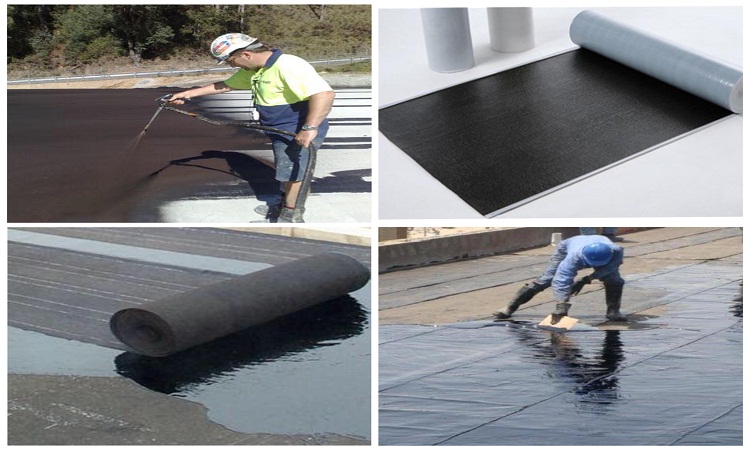A waterproofing membrane is a layer of water-tight material that is laid onto a surface to prevent water leak damage to the building. Waterproofing membranes consist of liquid applied or pre-formed sheet membranes. Waterproofing membrane can be adhered to or installed around the foundations to prevent water penetration. Whether it is to protect the basement or roof/slab of a building, waterproofing will help stop water from infiltrating your foundation & protect your structure from water damage.
Different types of Effective Waterproofing Membrane
Polymer-modified bitumen sheet membranes
The polymer-bitumen roll-fed sheet membrane is the most widespread material for the creation of the waterproofing layer. This is due to the ability to withstand wear, pressure, or damage of the material (durability) the relative simplicity of installation, and the stability of the factory-set technical parameters.
It sheet could also be used as an underlay for pitched roofs and as a vapor barrier. The material withstands high mechanical loads providing long-term and temperature fluctuations, effective and reliable waterproofing.
Polymer-modified bitumen sheet provides extra flow resistance that makes it possible to use the material in very hot weather conditions. On the bottom side, the material is covered by a polymer film with special graphic essences, melting of which indicates the proper material heating. Topside, the material is covered by a polymer film.
It is designed for installation as the bottom layer in a double-layer roofing system on buildings, for waterproofing of foundation and engineering structures. Can be used as an underlay bitumen shingles on pitched roofs. Used for new construction or repair.
Self-adhesive modified bituminous membranes
It is composed of polymers, tackifiers, and asphalt & may contain mineral stabilizers. The products may be reinforced with fiberglass, polyester, or a combination of fiberglass and polyester.
Self-adhesive modified bituminous designed for exposures to the elements are typically surfaced with films, coatings, or another nontransparent surfacing, mineral granules. The self-adhesive layer is protected with a release paper or film, which is removed during installation.
Self-adhesive modified bituminous membranes are packaged and stored in cardboard boxes or they are protected with opaque wrapping. It shouldn’t be stored in direct sunlight since exposure to UV rays may affect the adhesive properties, especially on the outer convolutions of the roll, or due to “dog-legging” of the roll storage for extended periods or under extreme conditions can alter the adhesion properties of the affect roll alignment.
EPDM membranes
Unlike bitumen based waterproofing membranes, there are no flames or torches required to install our EPDM membranes. These are installed using bonding adhesives. The installation is quick and more importantly, safe.
EPDM membranes come as a single component cementitious, polymer-modified non-reactive selective fiber-reinforced repair mortar to provide excellent/super properties as well as resistance to carbonation, corrosion & shrinkage cracking.
This can be applied in thickness from 10 mm – 40 mm in vertical and 25 mm in an overhead situation. It is suitable to apply by a special mortar spray machine or by hand trowel.
Thermoplastic roof membranes
Thermoplastic roof membranes for waterproofing set themselves apart from other commercial roofing systems. It is a blend of ethylene-propylene, polypropylene, and is often reinforced with polyester. The sheet of thermoplastic polyolefin (TPO) can contain UV absorbers, colorant, flame retardants, or other add-ins to achieve the required physical properties. Often white, thermoplastic polyolefin sheets can range in width from 6 to 12 feet and have varying thickness, usually 40 mils to 100 mils.
Thermoplastic membranes for waterproofing can be less expensive than other roofing options. Thermoplastic polyolefin (TPO) especially is seen as a lower-cost solution when it is time to repair a commercial roofing system. The lower cost of thermoplastic options does not mean the membranes wear out too soon. PVC and TPO single-ply membranes can last 15 to 20 plus years without significant repairs.
Liquid Applied Membranes
The liquid-applied waterproofing membrane is a fully-bonded, monolithic, liquid-based coating suitable for many waterproofing & roofing applications. The coating cures to form rubber-like elastomeric waterproof membranes & may be applied over many including asphalt, concrete & bitumen.
There is no need to strip off old roofing materials & applications that can go ahead without any disturbance to normal routines by brush, roller, or airless spray directly over the existing failed substrate/layer to reinstate total weatherproof protection. There is no need to strip out hazardous or odor solvents during the application, thus not disrupt normal routines in the building below.
Bituminous Membranes
Hot melt liquid bituminous waterproofing system with an interlaid reinforcement can be used in roof applications to provide a seamless waterproofing membrane for high applications as they can be laid at low temperatures.
Polyurethane Liquid Membranes
Polyurethane liquid membranes that have been designed for a range of waterproofing applications where the membrane is to be covered over with screeds, tiles, concrete beds, etc. They offer excellent or super adhesion properties overbuilding substrates including masonry, concrete, cement sheeting, wet area sheet surfaces, and plasterboard surfaces.








